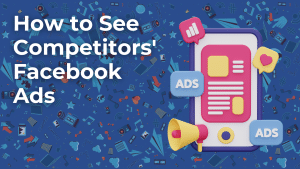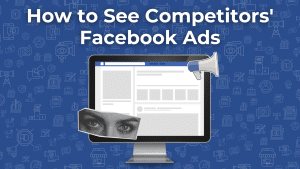
Would you like to learn how to see competitors’ Facebook ads?
Understanding your competition is crucial for marketing success. To do this, you can view their Facebook ads is one effective way to gauge your competitors’ strategies. This can provide insights into their advertising approaches, target audience, and promotional tactics.
This article is a straightforward guide to seeing your competitors’ Facebook ads and their benefits.
How To View Competitors’ Facebook Ads
Whether you’re a small business owner or a digital marketing professional, knowing how to access and analyze Facebook ads is invaluable. Below, we will walk you through the simple steps to viewing your competitors’ Facebook ads:
Step 1: Identify your competitors.
Start by listing the competitors whose strategies you want to analyze. These could be direct competitors within your niche or other businesses targeting similar audiences.
Step 2: Use Facebook Ad Library.
Through the Facebook Ad Library, Facebook offers a transparent way to view all active and inactive ads across its platforms. This tool is publicly accessible and does not require a Facebook account. Here’s how to use it:
- Go to Facebook Ad Library.
- In the search bar, type the competitor’s Facebook page name. Make sure you have the correct spelling and page.
- You can filter the Ad Library reports by region, ad types, and the platforms the ads are running on (e.g., Facebook, Instagram, Messenger).
Step 3: Analyze the ads.
Once you find your competitor’s ads, take some time to analyze them. Look for:
- Ad Content: What messages are they using? Are there recurring themes or offers?
- Visuals and Media: Are they using photos, videos, or other media types?
- Targeting and Placement: Although exact targeting details aren’t shown, you can infer the audience based on the ad content and the primary language used.
- Ad Performance: Some ads display engagement numbers such as likes, shares, and comments, which can give you a hint about the ad’s performance.
Step 4: Take notes and adapt.
Take notes on what might work for your campaigns based on your observations. Consider testing similar messages, formats, or creative strategies. However, ensure your ads are tailored to your brand’s voice and audience.
Step 5: Monitor regularly.
Competition can change rapidly, especially in dynamic industries. Make it a routine to check the Ad Library regularly to stay updated with new trends and tactics.
Why You Should View Competitors’ Ads Details

In digital marketing, staying ahead means monitoring your ads and competitors’ actions. Facebook is a critical platform for this, thanks to its vast reach and diverse user base. Analyzing your competitor’s Facebook ads can provide a wealth of information that can help refine your marketing strategies. Here are the key benefits of conducting such an analysis:
1. Understand market trends.
Analyzing your competitors’ ads can reveal the latest trends in your industry. This includes popular promotional tactics, emerging products and services, or even shifts in consumer preferences. By staying updated on these trends, you can ensure your own Facebook ads remain relevant and competitive.
2. Refine your own targeting strategy.
By observing the kind of audience your competitors target, you can learn a lot about market segmentation. Although Facebook doesn’t show precise targeting details, you can infer target demographics based on the ad content and the language used. This insight can help you adjust or expand your Facebook pages’ targeting criteria to better reach potential customers.
3. Inspiration for ad content.
Sometimes, coming up with fresh and effective ad content can be challenging. Looking at your competitors’ ad details can spark ideas for your creative strategies. It’s about learning what messages, images, and calls-to-action resonate with your shared audience. Use these insights as a springboard to craft compelling content that stands out.
3. Benchmark ad performance.
If your competitors’ active ads get significant engagement, it might indicate what could also work for you. While exact performance metrics aren’t available, visible reactions like likes, shares, and comments can provide a proxy for ad effectiveness. This benchmarking can be invaluable in setting performance goals and expectations for your own campaigns.
4. Identify gaps in the market.
Analyzing your competitors’ advertising can also show you what they are not doing. These gaps in their marketing strategies can represent opportunities for your brand to differentiate itself and capture an underserved market segment.
5. Cost efficiency.
Understanding what works well for others can save you from spending on trial and error with your ad campaigns. By learning from the successes and failures of your competitors, you can allocate your budget more effectively. Therefore, you can focus on proven strategies and avoid less effective ones.
6. Proactive strategy adjustments.
Regularly analyzing competitor ads helps you stay proactive rather than reactive with your marketing strategies. It enables you to anticipate shifts in the industry and adjust your campaigns ahead of time rather than scrambling to catch up.
Conclusion
Viewing your competitors’ Facebook ads can provide valuable insights and help refine your marketing strategy. Tools like the Facebook Ad Library allow you to stay ahead of the curve and adapt your campaigns for better performance. Remember, the goal is not just to copy but to learn and innovate based on what’s working for others in your industry.
Don’t have time for this? We can handle it for you. Contact the leading Facebook ad agency today.
Frequently Asked Questions
Do I need a Facebook account to view competitors’ ads?
You don’t need a Facebook account to view competitors’ ads.
Can I see how much my competitors are spending on their Facebook ads?
Facebook does not specify how much money is spent on individual ads. However, you can infer the scale of its campaigns based on the number of ads it runs and the variety of its content.
How can I tell which of my competitor’s ads are most successful?
You can gauge an ad’s success by looking at visible engagement indicators like likes, comments, and shares.
